The post Soil Farmer of the Year 2023 – Farm Walk with Richard Anthony appeared first on Farm Carbon Toolkit.
]]>Richard Anthony, of R & L Anthony near Bridgend, was awarded Second Place in the 2023 Soil Farmer of the Year competition. He was commended on how he responded to and managed challenges, never veering from thinking holistically, always upholding soil health as a priority, and treating each challenge as something from which to learn.
A majority arable business, Richard farms a 6-year rotation of wheat, maize, oilseed rape and westerwolds intermixed with a diverse array of cover and companion crops which he is passionate about. “The emphasis on farm is the soil, improving the soil and organic matter, and keeping a crop in the ground; keeping the soil biology alive.”
Richard and the team also strive to promote and create habitats for wildlife: planting wild bird seed mixes, establishing wildlife corridors, and bordering all hedgerows with a 3m margin to encourage growth year on year. 2m flower margins have also been implemented around all fields of oilseed rape which has been, to quote, “absolutely fantastic.” Encouraging insects and bees and getting the public on side too.
The farm walk itself took place on 23rd November 2023 and kicked off with a presentation taking us through the past year and outlining the various activities and obstacles the farm faced. We were then treated to a fantastic farm walk whereby Richard gave our group of visiting farmers, agronomists, and advisors a tour of some of what they get up to across their extensive arable and forage business.
A big part of what Richard and his team are trying to achieve across the farming business is to use very little bagged fertiliser. Most of the nutrients applied to the soil come from digestate, conveniently stored in the farm’s digestate lagoon. Tankers come in and fill alligator bags for easy transport and the digestate is spread on wheat, oilseed rape and maize.
So far, Richard has managed to eradicate artificial fertiliser when growing maize and OSR; however, wheat still receives a small amount of early application. This wouldn’t have been possible without the construction of the digestate lagoon, a project which was undertaken at the beginning of last year. Still, as Richard says, there is room for improvement. The farm is looking to reduce its N inputs even further by trialling an N inhibitor, all to build more resilience into the system.
This mindset has been applied to fungicides. To use less, Richard has changed the sprayer to accommodate the wet and windy weather brought in from the coast. Now at 250cm spacing, the booms can run very low resulting in no drift even if it’s windy. This enables more spray days and a better chance at getting the timeliness right.
As with most farms across the UK, the weather has been the biggest challenge with dry weather in May and June, and then rain as soon as harvest began.
Luckily, Richard had installed a biomass boiler 6-7 years ago for grain drying after a very wet harvest having heard about them in Scotland. It has been a game changer. Their 1-megawatt biomass boiler provides a lot more spare heat than previous methods of grain drying where they used up to 1.2 megawatts of gas on one drying floor. In the old system, if they were on 25% moisture, it took 10 days to dry one side. With the biomass boiler on woodchip, they can dry 2 drying bays, double the output, and never have to run the boiler flat out. With the right combine (Richard uses a MacDon belt header), the corn is cut as soon as it gets to 25% and achieves good output, as Richard emphasises “do not wait”.
Planting OSR in August was a struggle, with some fields too wet to put a tine in and any cultivation out of the question. Instead, Richard planted the wet parts of the field by snipping the OSR with a sprinter drill and planting the dry parts with a farm standard drill and a top down.
To better manage the unpredictable weather, Richard has a selection of drills that he’s held onto rather than sell. The farm will run 2, sometimes 3 drills if they can, capitalising on days when they have the right weather. This was especially helpful during autumn when the farm received 295mm of rain in October alone.
The farm also spends a lot of time on drainage. Ditches are cleaned, dug out, drains put in; all with the aim of evening out patches in fields and making the farm more resilient. As Richard says, it’s great getting 16t/ha on wheat in a bit of field but if you’re only getting 3t/ha in another part because it’s too wet there is space to do better.
Still, the most used bit of kit on the farm is a spade. By continually monitoring and assessing soil structure, Richard can make a well-informed decision when determining how to establish the next crop.
Farm Walk
During the farm walk, we were shown multiple cover crop and companion crop trials that were taking place on the farm. Steve Corbett from Agrii has worked with Richard for many years, trialling different varieties and combinations, highlighting the importance in being selective. You need good establishment, and it must earn its keep.
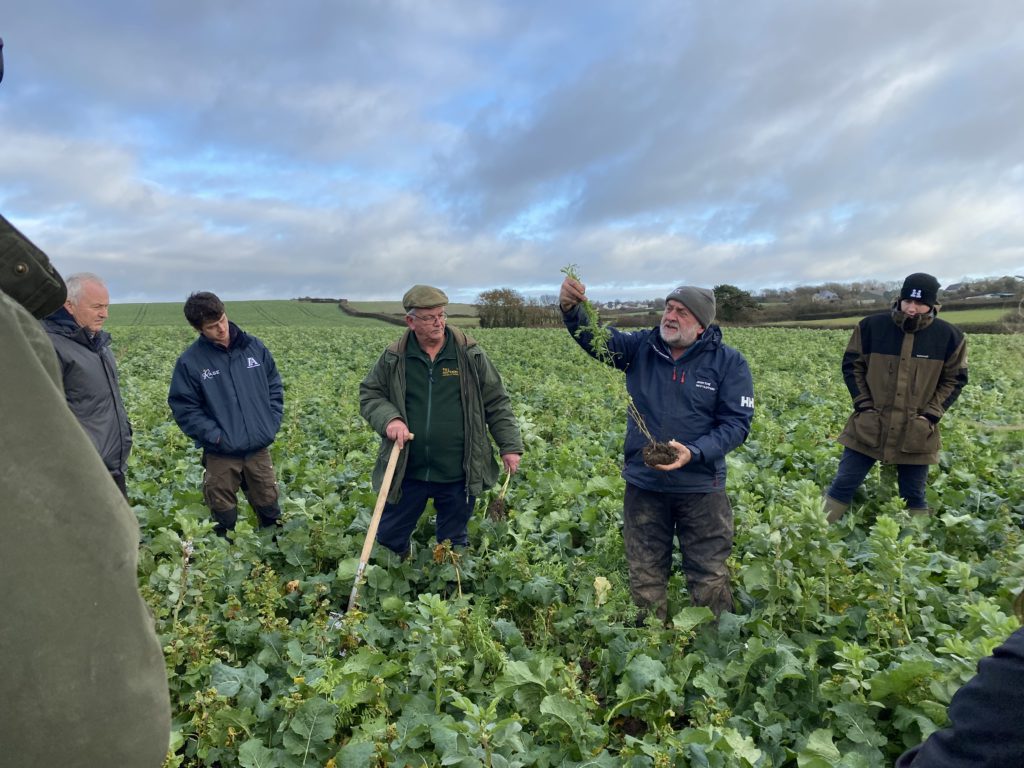
What they have found is that OSR, a “lazy rooting brassica”, completely lends itself to companion cropping, in this case with beans, spring vetch and buckwheat. Beans help to get the roots down as well as provide free nitrogen through nodulation. Spring vetch as opposed to winter vetch grows quickly providing biomass and N fixation. Buckwheat adds to the canopy, slowing down flea beetle, making it more difficult for pigeons to land, as well as mining phosphates. When the companion crops die, all the fixed nitrogen and phosphates will be released back into the soil ready for the next crop.
Richard deliberately plants OSR at low seed rates to encourage big branchy plants in spring which will grow away, allowing light through the canopy. By choosing thicker and well-branched OSR types, flea beetle is more contained, damaging only the outer leaves, leaving the middle to branch out. In Richard’s experience it provides a plant that will survive despite a pest living within it.
In terms of cultivation, Richard is a big fan of direct drilling. When direct drilling wheat, he believes it is important to see what is happening underground: what is the root depth? Taking stock of root depth and maintaining that attention to detail during crop growth is essential to determine the next steps in terms of cultivation. At Sealands farm, root depth is critical to survive the winds, Richard has found through monitoring that cultivation disrupts root growth, and that direct drilling fits his system best.
Ultimately, Richard has tried a lot which didn’t work out, but he’s kept at it. One outcome which has surprised him the most was the success of forage rye which he believes is underestimated. In the field, Richard showed us the root mass it was building and the excellent soil structure it yielded. This has provided Richard with an extra income stream, either taken for silage or grazed (ensuring to move stock on in wet conditions to avoid undoing all the good work he’s built up!).
Looking to improve the soil structure even further, Richard planted the forage rye together with westerwolds. He found that they were able to harvest the westerwolds a fortnight earlier due to the ability of the forage rye to get away in the spring creating its own microclimate which Richard believes benefitted the westerwolds.
Finally, we heard about Richard’s problem with persistent perennial ryegrass. In this instance, he introduced an annual ryegrass to outcompete the perennial. “Putting in a bully to outcompete a bully”. It worked and Richard is now able to include it within the arable rotation without generating a loss. This allows a rest period within the rotation to build fertility, stabilise soil structure and generate a bit of extra cash from silage or grazing. Essentially, Richard is maintaining the balance of farming resiliently: optimising soil health and crop yields while sustaining a viable business.
As we’ve all come to realise, we can’t rely on the weather, however, prioritising soil health as perfectly exemplified by Richard, can better equip us to respond and adapt. When we get to know our soils, monitoring how they behave in certain conditions and how they respond to our actions, we are better prepared and forearmed to make decisions that will affect future harvests and pocket.
Through trials and problem solving, Richard together with Steve have implemented more diversity and reduced inputs without damaging profits. A big resistance to straying from our well-known and “safe” rotations is often down to “how will it pay for itself”. Richard and Steve have shown that they’re not radical in their rationale for cover and companion crops, the bottom line is it has to pay. The most exciting take home from the day is they didn’t give up: they’ve found the right species to incorporate, the soil health on farm is improving and crop yields are directly benefiting. It was a truly inspiring day and a masterclass in perseverance. Richard hasn’t made it look easy by any stretch but as he puts it “we’re just learning all the time.”
You can read the full report here.
The post Soil Farmer of the Year 2023 – Farm Walk with Richard Anthony appeared first on Farm Carbon Toolkit.
]]>The post Soil Biodiversity appeared first on Farm Carbon Toolkit.
]]>By Stefan Marks, Farm Carbon and Soil Advisor
One gram of soil can contain one billion bacteria and up to 10,000 different species of bacteria with only 1% of organisms estimated to have been identified.
The soil functions as part of a vital living system which supports crop and animal health, underpinned by massively complex interactions between the biological, chemical, and physical properties of the soil. Life in the soil is often underestimated, spanning millions of species and billions of organisms which account for the highest concentration of biomass from anywhere on the planet. Fertility and crop performance are at risk of being distilled down to the chemical or physical constraints of the soil in isolation. This encourages an oversimplified approach to soil management. Sustainable Land Management, and the move towards regenerative agriculture encourages a more holistic management of the soil, resulting in enhanced biological diversity and so delivering the key benefits. It is important to recognize the importance of soil biology without overthinking its complexity, after all, we cannot manage for individual microbial species.
Soil Microorganisms
Soil microorganisms describe both bacteria and fungi, whose abundance makes up much of the biological biomass in the soil. Bacteria and fungi produce a range of enzymes which can break down and absorb inorganic and organic matter which is later made readily available as nutrients to plant roots. Fungal communities form larger hyphae ‘networks’ which are beneficial in mobilising nutrients in mutualistic exchanges with rooting structures. These fungal hyphae can extend over great distances and further help with the aggregation of the soil, improving soil stability, water holding capacity and therefore a greater resilience to droughts and waterlogging.
Bacteria exudates form the ‘glues’ which facilitate the formation of microaggregates from soil particles and as well as increasing the cycling of nutrients with a particular focus on the nitrogen cycle. Both fungi and bacteria are responsible for the breakdown of organic matters within the soil profile and so populations benefit greatly from manure applications.
Due to their short life cycles, the population of these organisms may shift rapidly as a result of changes to their environment including the soil temperature, moisture and chemical composition. A healthier soil will generally have higher microbial biomass and will benefit from a larger fungal-to-bacterial ratio. Applications of agrochemicals and fertilisers can impact populations with overapplications of nitrogen promoting a more bacterially dominated soil. Likewise, tillage can break up the fungal hyphae which are more sensitive to physical disturbance.
Soil Macrofauna
The macrofauna are larger organisms which inhabit the soil with perhaps the most notable being the earthworm. Not only do earthworms operate as ecosystem engineers to enhance the soil and provide a better environment for other plants and animals to reside but they are an excellent indicator of soil health. Whilst it can be difficult to measure soil biodiversity the presence of earthworms indicate, on a larger scale, a healthy operating food web with a distribution of organisms across all trophic levels. As such earthworm numbers have become a good metric for biological soil health which are a result of and have an impact upon the chemical and physical properties of the soil. Earthworms fulfill different functions based on their niche, with the three main groups being:
- Epigeic – Inhabit litter layer and cycle carbon
- Endogeic – Topsoil dwelling and enhance soil aggregation and nutrient mobilisation
- Anecic – Deep burrowing improving porosity, water infiltration and root development
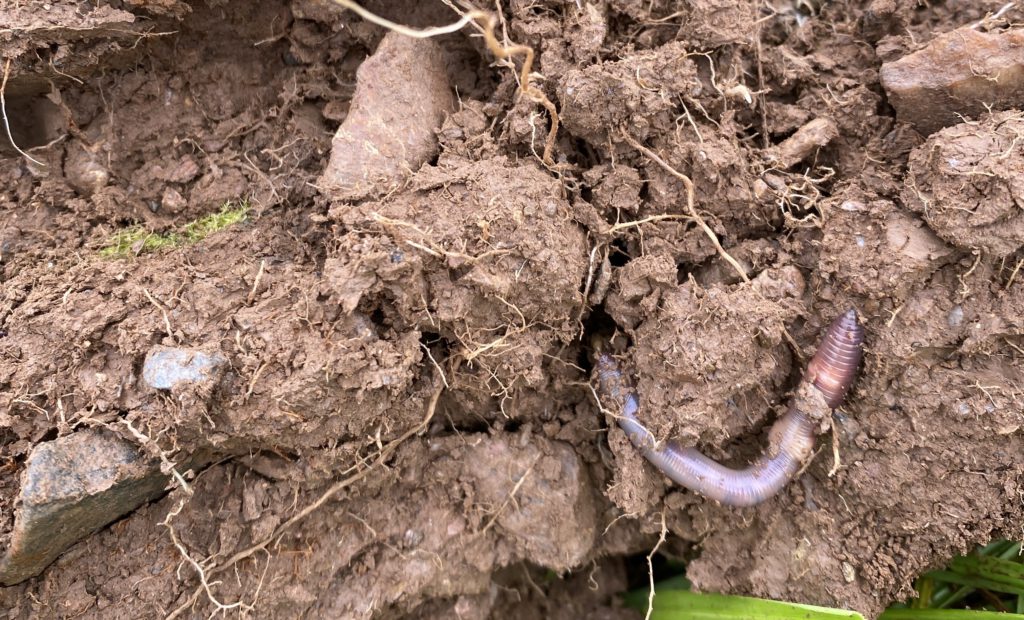
Considerations for Biological Soils
- Feed the soil: amendments of organic matter will benefit soil organisms as it provides a feed source for them to thrive on. Conversely the greater the soil fauna populations the quicker and more available the nutrients. Over applications of inorganic fertility sources can have a negative impact causing the soil to become too bacterially dominated.
- Crop diversity: the greater the crop diversity the greater the diversity in below-ground populations as there is a greater range of plants to feed and interact with in the growing environment. This necessitates the implementation of more diverse crop rotations into arable systems and will benefit from greater diversity in grassland with the inclusion of legumes and herbs.
- Reduced tillage: tillage can have an adverse effect on established populations of soil organisms from the fungal hyphae all the way up to the earthworms. A move towards less intensive tillage through the adoption of no-till or min-till establishment at suitable parts of the rotation will help to maintain soil biological populations.
Overall, the biological component of the soil should not be overlooked as it is an essential part of a vital, living soil. Allowing soil to function properly will bring a host of benefits which can result in real world cost savings. Chief among these benefits may be the increased resilience in a changing climate.
The post Soil Biodiversity appeared first on Farm Carbon Toolkit.
]]>The post Farm Net Zero April 2024 update appeared first on Farm Carbon Toolkit.
]]>
Welcome to our April Farm Net Zero newsletter, sharing updates for our farmers, growers and the wider community this project supports.
(Image above: Dr Hannah Jones/FCT presenting at the ORFC)
Recent news and events
Oxford Real Farming Conference: January 2024
An intrepid band of Farm Net Zero farmers and project staff made their way to Oxford for the Real Farming Conference where we were presenting a session called “It Takes a Farm Community to be Net Zero: A Case Study from Cornwall”. This was a sell-out, with people queuing to get in, and helped to demonstrate the excellent work the FNZ farmers are doing as part of their communities. The film we produced was well-received, even earning a “whoop” from the crowd! It is available to watch here: https://farmcarbontoolkit.org.uk/2024/01/18/five-farms-in-cornwall/.
As well as the impressive range of sessions we were able to attend (covering everything from the role of vets in ecological sustainability to farm succession planning), we watched the premiere of “Six Inches of Soil” – a new film about farming starring Farm Net Zero monitor farmer Ben Thomas and featuring Farm Net Zero’s own Hannah Jones.
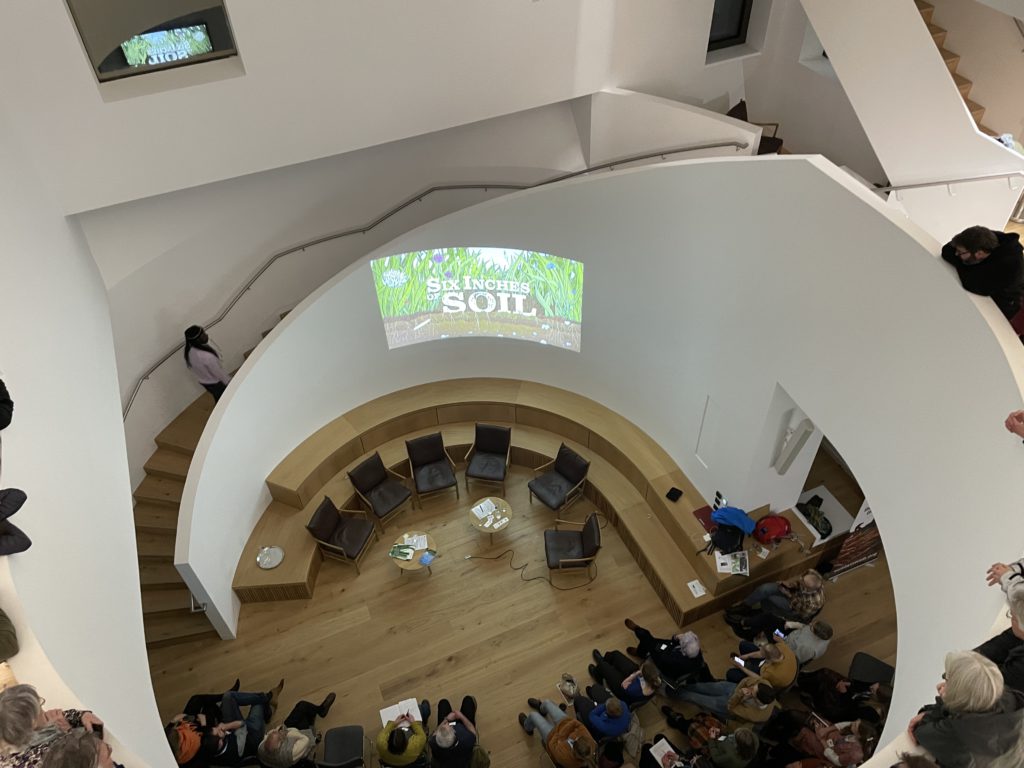
Community film screening 25th March
On Monday 25th March, we showed the Farm Net Zero Community Film at Stoke Climsland Parish Hall. This event was very well attended by members of the local community, drummed up by Bonny Lightfoot and Martin Howlett, FNZ monitor farmers and stars of the film. Following the screening, there was a panel session with the farmers where attendees were able to ask questions on climate change, biodiversity and how the project farmers are working together to address these issues.
We ended the session with the farmers’ visions of farming in the future, with all agreeing that there will be more of a mix and integration between farming and nature.
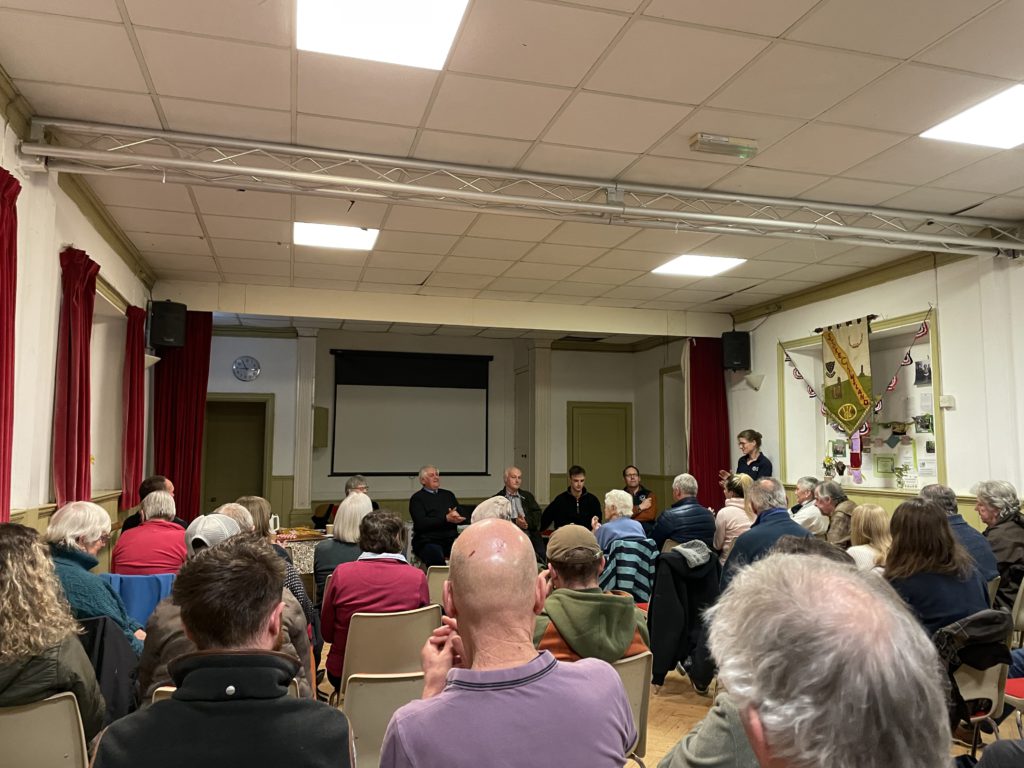
“Filming on Your Phone” Workshop
We ran our second “Filming on Your Phone” workshop with Down to Earth Media just before Christmas. This gave a group of farmers the opportunity to learn about how to share their stories and the good work they are doing. Since the start of the project, 12 farmers have now received media training.
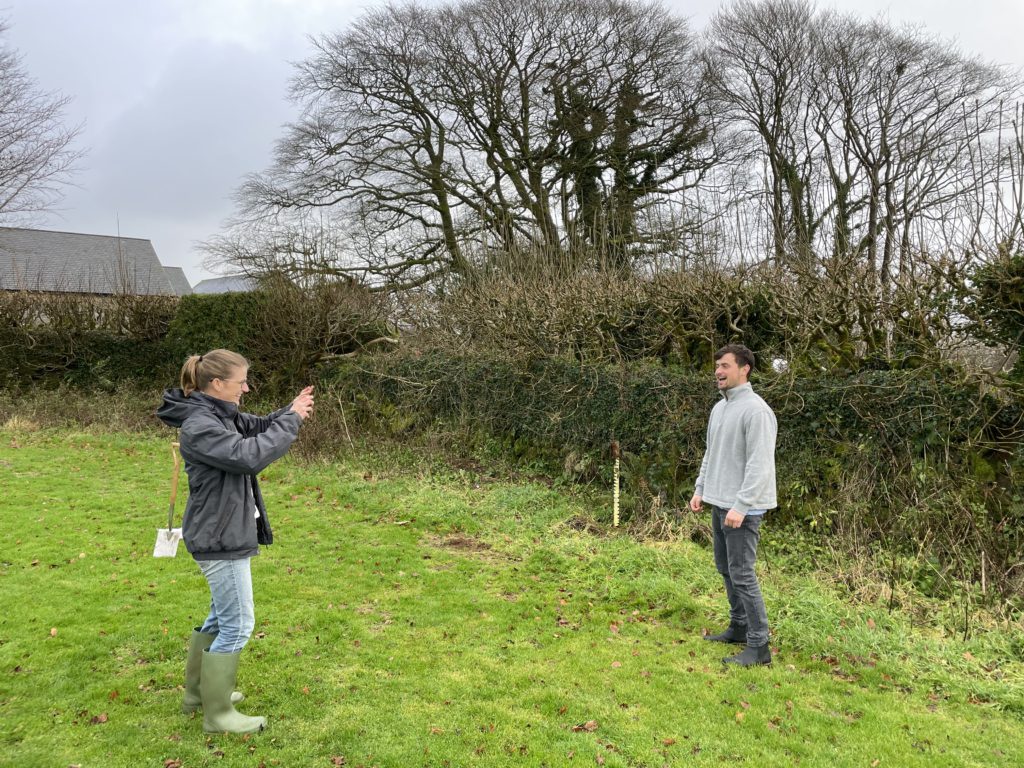
Summaries of all these events, and many more, are available on the Farm Net Zero Project Resources webpage.
Agri-Carbon Kernow
The success of Farm Net Zero has led to a short project funded through Cornwall Council’s Shared Prosperity Fund, to work with farms in Cornwall on carbon, biodiversity and water management plans. This project is a collaboration between the Rural Business School, Farm Carbon Toolkit, Westcountry Rivers Trust and Cornwall Wildlife Trust. If you are a farmer interested in taking part, please contact [email protected]
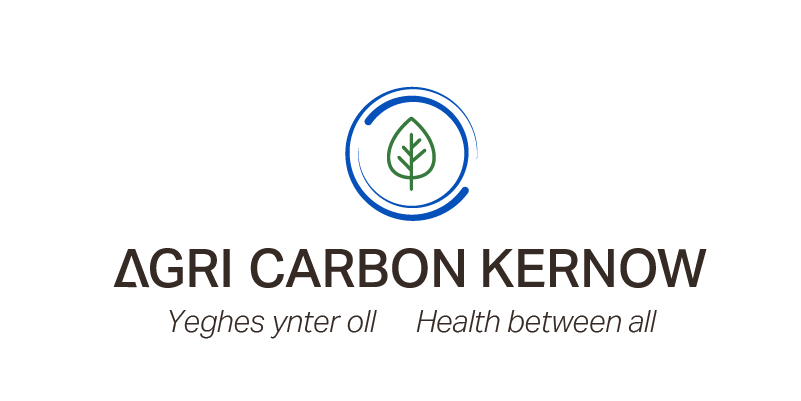
Falmouth Climate Change event
The Farm Net Zero team was present at the Climate Change Exhibition held at the Polytechnic (“the Poly”) in Falmouth on March 8th and 9th. The event, which was organised by Falmouth Rotary Club, was aimed at raising awareness amongst the general public. We were able to share some of our great work with passers-by, and as a result of our presence at the event, we have been asked to host a visit by two Cornish MPs this Spring.
Demo farm and field lab update
Inter-cropping cabbage
The inter-crop sampling for the cabbages has just been completed at Ennis Barton, one of our FNZ demo farms. This is a collaboration between Andrew Brewer and Andy Williams of Riviera Produce Ltd. Soil samples have been sent away for assessment of soil organic matter, but it is the impact on soil aggregate stability, and water infiltration that is of particular interest in this short term winter cover crop. A mix of buckwheat , phacelia, white clover, plantain and chicory was broadcast between cabbages in 4 blocks across 4 fields and compared to the control treatment of no cover crop. More data to follow.
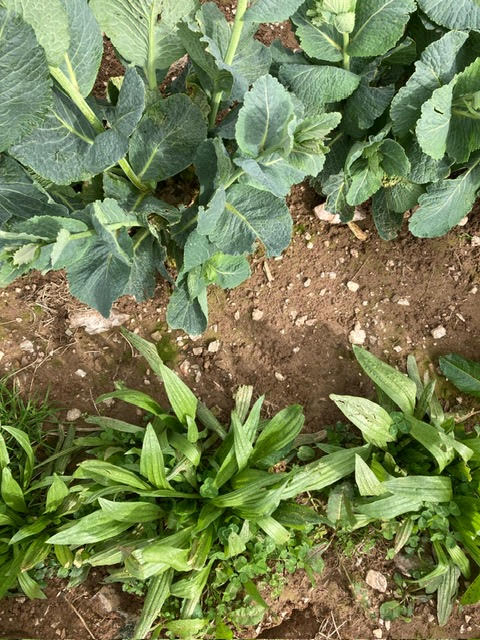
Farm Net Zero maize trials
This is the second year of the FNZ – Innovative Farmers maize field lab. This trial is evaluating the effects of different establishment methods, such as strip till and under sowing, on maize yield and soil health. For example, at Duchy College the trial plans involve splitting a maize field between conventional establishment and reduced cultivation and then trialling undersown mixtures in the opposite direction across the field.
This year we have teamed up with Plymouth University who will be carrying out some more in-depth soil testing. If you’re interested in taking part in the trials please do get in touch: [email protected].
We have a meeting planned for the triallists and researchers on 3rd April near Bodmin.
More information on last year’s trial can be found here: https://www.innovativefarmers.org/field-labs/fnz-maize-field-lab/
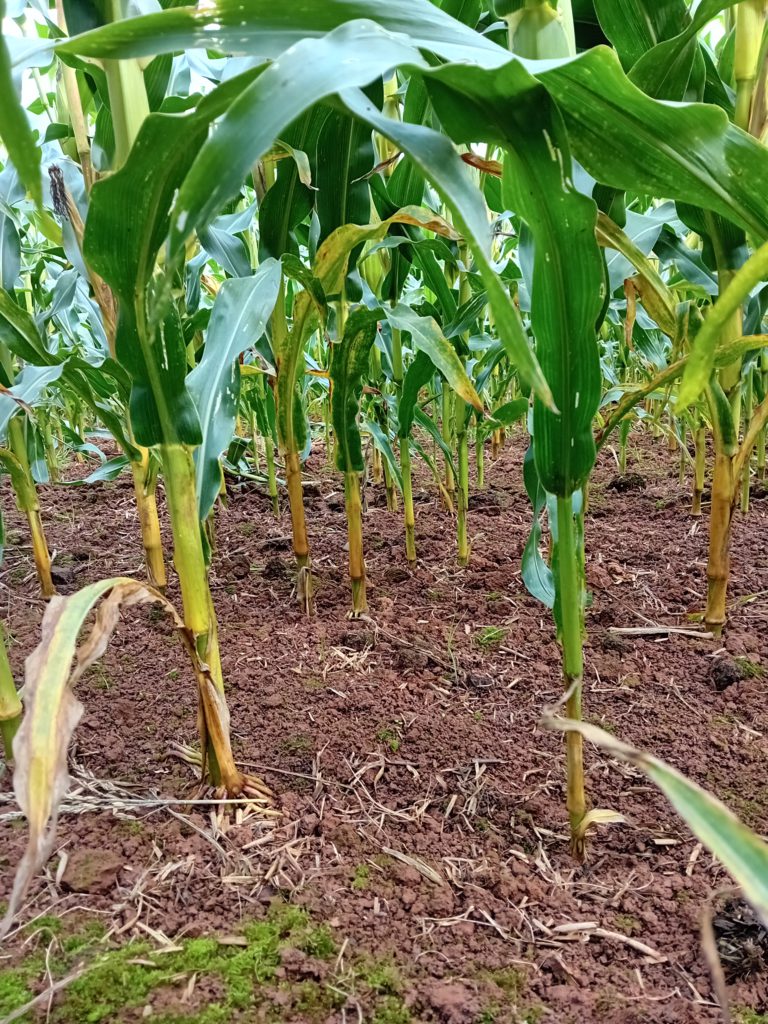
Diverse covers and leys to reduce worm burden at weaning
Weaning shock in lambs can cause physiological stress and slow growth rates. But this effect could be offset by enhanced forage protein content.
Two of our monitor farmers, Matt Smith and Anthony Ellis, have teamed up with the Farm Carbon Toolkit to launch a new Farm Net Zero trial, examining the effect of protein rich cover crops on lamb growth rates. This Innovative Farmers field lab will test a bespoke chicory-rich mixture for lamb weaning. The farmers hope it will improve growth rates, reduce lamb production footprint, improve soil health and lamb welfare, as well as reduce the need for wormers.
For more information see the field lab page on the Innovative Farmers website: https://www.innovativefarmers.org/field-labs/diverse-covers-and-leys-to-reduce-worm-burden-at-weaning/

Farm Net Zero field lab – herbal leys for dairy
This spring sees the launch of the Farm Net Zero and Innovative Farmers dairy field lab. In this trial Andrew Brewer, Farm Net Zero monitor farmer, will be exploring the question of whether different pasture species impact milk yield and constituents.
Andrew will split his dairy herd, grazing one group on standard ryegrass and clover leys, and the other on diverse swards/ herbal leys. Forage samples will be taken ahead of the cows moving in to graze. The milk yield and constituents from the trial cows will then be measured regularly throughout the 2024 growing season.
The project is being carried out in collaboration with the University of Bristol
and Cornwall Wildlife Trust and will deal with the big question many dairy farmers want answered. Dr Daniel Enriquez Hidalgo of University of Bristol, has been leading the study design and will be carrying out the results analysis. We are grateful to Andrew for all the extra hard work the trial will involve.
For more information on the field lab, see the Innovative Farmers website page: https://www.innovativefarmers.org/field-labs/fnz-herbal-leys-and-dairy/#

Dock Control Field Lab
Last years ‘How to rejuvenate pastures’ hosted by James Barrett has led to a new field lab. James rotaseeded a dock-infested grassland and destroyed docks just by addressing surface compaction.
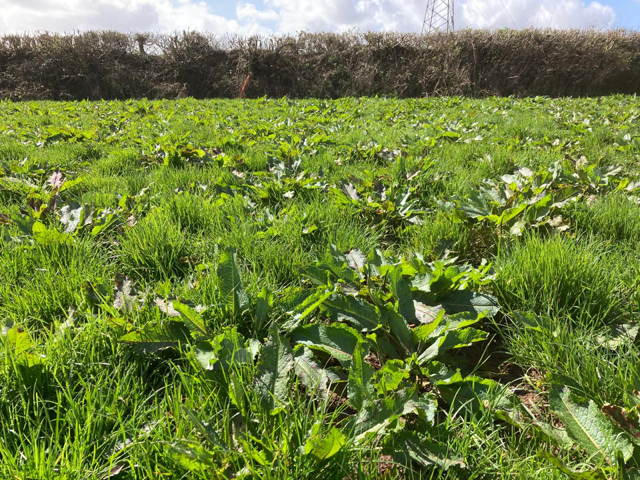
Calcium levels were also found to be at good levels in the soil. The new field lab will be recruiting up to 10 farmers, a field each, to test out the impact of optimising soil structure through mechanical intervention and the use of granular and foliar calcium application. Please contact a member of the FNZ team if you would like to be involved.
What next?
Workshop “Gardening & Trees” – with FNZ & Nourish Kernow,
Sunday April 21st, 1:30pm – 4pm, Higher Culloden Farm, College Road, Camelford, PL32 9TL
As part of our community engagement activities, Westcountry Rivers Trust’s Farm Net Zero team are joining Nourish Kernow for the project’s next climate-friendly gardening workshop.
Learn about the environmental benefits of planting trees, shrubs, and perennial plants alongside food crops. The event will include a hands-on soil health assessment that you can try at home, plus ideas to help you manage your garden to best sequester carbon and adapt to a changing climate, as well as boosting biodiversity.
We will be taking a look at the trees recently planted at the farm to support its habitat management plan and hearing about the inspiration and challenges behind the farm’s wider Community Supported Agriculture project to create a regenerative market garden on the edge of town.
Have fun as you learn about the environmental benefits of planting trees, shrubs, and perennial plants alongside food crops at home.
Book here
Farm Net Zero farm events
We will be continuing to run a series of Farm Net Zero events in 2024, drawing on the needs and interests from the community of farmers. These will be advertised on our website and through this newsletter. If you have any suggestions for events we could run, please let us know.
You’ll find a full range of relevant events on our website.
Click here to view our full events page
Getting in touch
As ever, if you have any questions or ideas that would further support the community of farmers that we are working with, please get in touch with the project team (contact details below).
All information about the project including upcoming events and resources are available on the Farm Net Zero website. If there is anything you would like to see featured please let us know.
This project, funded by the National Lottery Community Fund, is a partnership between Cornwall College, The Farm Carbon Toolkit, Duchy College’s Rural Business School, Westcountry Rivers Trust, Innovative Farmers and Innovation for Agriculture.

The post Farm Net Zero April 2024 update appeared first on Farm Carbon Toolkit.
]]>The post New Calculator Updates – April 2024 appeared first on Farm Carbon Toolkit.
]]>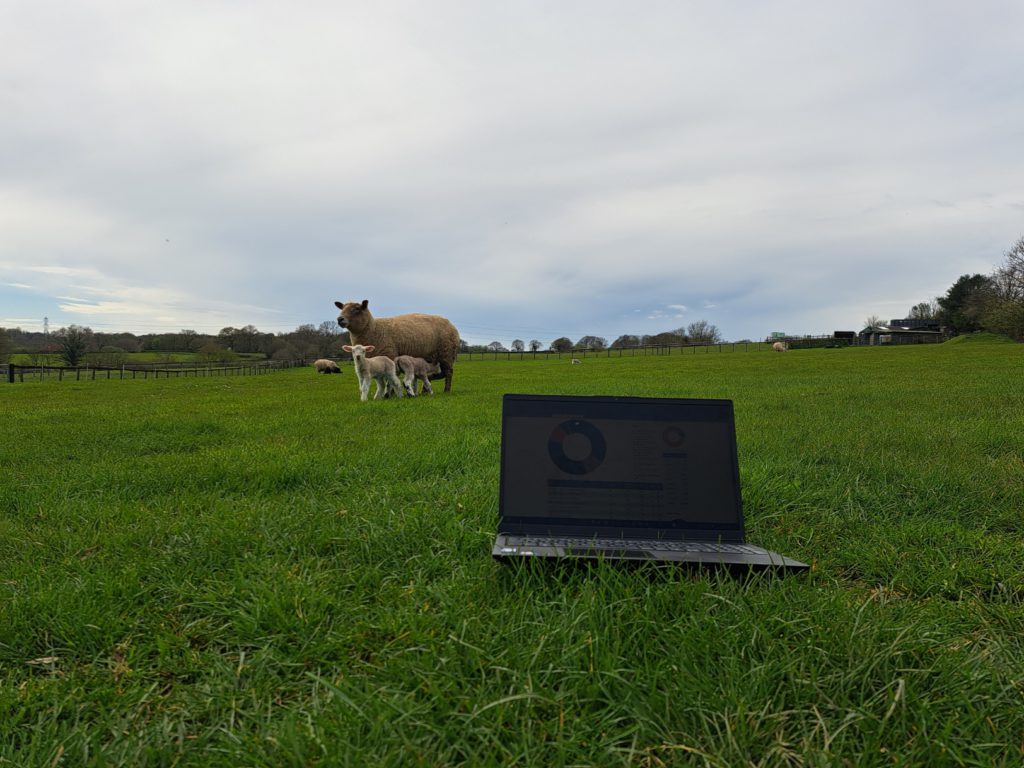
The FCT Calculator team has released a significant update to the Farm Carbon Calculator, designed to ensure that your reports reflect the latest emissions data and understanding available. This update, which will affect any reports ending after 1st April 2024, encompass a range of improvements aimed at enhancing report accuracy, flexibility and calculator usability. Below are some of the main changes you will see to the calculator.
Updated emissions factors
We want to ensure that your reports align with the most recent scientific research and methodologies, and to that end we have updated our emissions factors across various categories, including:
- Updated UK GHG Inventory factors to the latest data (affects fuels, materials, distribution, processing, inventory and waste)
- Updated the livestock, cropping and input emissions factors in line with the most recent IPCC standard refinements
- Updated woodland sequestration factors in accordance with the latest Woodland Carbon Code
Numerous other emissions factors have been updated across the calculator, and for a more extensive breakdown of these changes, see Table 1 of our “What’s new for April 2024 update” document on the Calculator resources page.
New factor options
In this update we have also expanded the options available when report building to offer more comprehensive coverage of farm businesses. The new factors we have added include:
- New fuel options such as alternative diesels and purchased heat and steam
- Diverse new material options, such as more fencing materials, piping options, packaging choices, and agricultural consumables.
- Expanded imported organic fertility and cropping options, including whole cropping
- New fertiliser (including liquid fertilisers) and spray options, with provisions for unlisted items
- Inclusion of hay and haylage as livestock feed options
- Expanded distribution options, including electric vehicle haulage and various air freight options
Alongside adding new options, we have provided some more refined options for existing factors in the calculator, including:
- New managed hedgerow options, to allow reports to reflect the higher biomass accumulation of young hedges
- We now have a non-UK electricity option for international users, allowing you to input your emissions using your nation’s specific emissions conversion factor
- More options for structures, including new agricultural building size options and various new complete fencing options
A full overview of the new additions and refined items are available in Table 2 of the “What’s new for April 2024 update” document, as well as flagged in the new data collection sheets available on our Calculator resources page.
Accounting for Capital Items
With this update we have provided more flexibility in how capital items (such as farm machinery or agricultural buildings) are accounted for to ensure that your reports are in line with your desired reporting approach. You can choose to account for capital items in two ways:
- “Depreciating over 10 years” – The legacy method with emissions “spread” over a 10 year period
- “Upfront” – an approach which is compliant with the GHG protocol agricultural guidance. This way embedded emissions from capital items are associated with the year they were purchased, and only the emissions from your reported period will be included in your report
Not all standards require the inclusion of capital items, so if you are producing a report for someone else you should check whether they want capital items included.
You can also switch between inventory reporting options by going to “Edit Farm Details” and you will not lose any data switching between the two.
Reporting waste
A new waste disposal reporting approach has been developed to ensure there is an accurate assessment of emission and these are accounted for in a GHG protocol compliant manner. How waste is reported can be selected on the report information page as with the new inventory options:
- “Legacy” is the existing approach which compares emissions from disposing of wastes to what would have been emitted had the waste been sent to landfill (i.e. it includes “avoided emissions”)
- “GHG protocol compliant” is the new recommended option as it discounts any “avoided emissions” and accounts just for the emissions resulting from the disposal method selected
New Data Collection Sheets
To facilitate data collection, we provide updated sheets with all new calculator items flagged for easy reference. You can find these on our Calculator resources page.
More information
For a more detailed overview of these changes and the methodologies behind them, please visit our Calculator resources page. Additionally, our website offers various help and guidance to assist you in reporting your farm businesses’ carbon footprint.
We are dedicated to providing an accurate and user-friendly carbon calculator that can help farmers improve their business and environmental resilience. This update has been the product of the hard work from our team in response to contributions and feedback from our users, so if you have any queries or insights for the calculator please email us at [email protected], and we will work to make this the most accessible and informative tool for you.
The post New Calculator Updates – April 2024 appeared first on Farm Carbon Toolkit.
]]>The post New Farm Net Zero Trial – Reducing Worm Burden at Weaning appeared first on Farm Carbon Toolkit.
]]>Weaning shock in lambs can cause physiological stress and slow growth rates. But this effect could be offset by enhanced forage protein content.
Two of our monitor farmers, Matt Smith and Anthony Ellis, have teamed up with the Farm Carbon Toolkit to launch a new Farm Net Zero trial, examining the effect of protein-rich cover crops on lamb growth rates. This Innovative Farmers field lab will test a bespoke chicory-rich mixture for lamb weaning. The farmers hope it will improve growth rates, reduce lamb production footprint, improve soil health and lamb welfare, as well as reduce the need for wormers.
For more information see the field lab page on the Innovative Farmers website: www.innovativefarmers.org/field-labs/diverse-covers-and-leys-to-reduce-worm-burden-at-weaning/
The post New Farm Net Zero Trial – Reducing Worm Burden at Weaning appeared first on Farm Carbon Toolkit.
]]>The post Farm Net Zero at Oxford Real Farming Conference 2024 appeared first on Farm Carbon Toolkit.
]]>An intrepid band of Farm Net Zero farmers and project staff made their way to Oxford for the Real Farming Conference where we were presenting a session called “It Takes a Farm Community to be Net Zero: A Case Study from Cornwall”. This was a sell-out, with people queuing to get in, and helped to demonstrate the excellent work the FNZ farmers are doing as part of their communities. The film we produced was well-received, even earning a “whoop” from the crowd! It is available to watch here: https://farmcarbontoolkit.org.uk/2024/01/18/five-farms-in-cornwall/.
As well as the impressive range of sessions we were able to attend (covering everything from the role of vets in ecological sustainability to farm succession planning), we watched the premiere of “Six Inches of Soil” – a new film about farming starring Farm Net Zero monitor farmer Ben Thomas and featuring Farm Net Zero’s own Hannah Jones.
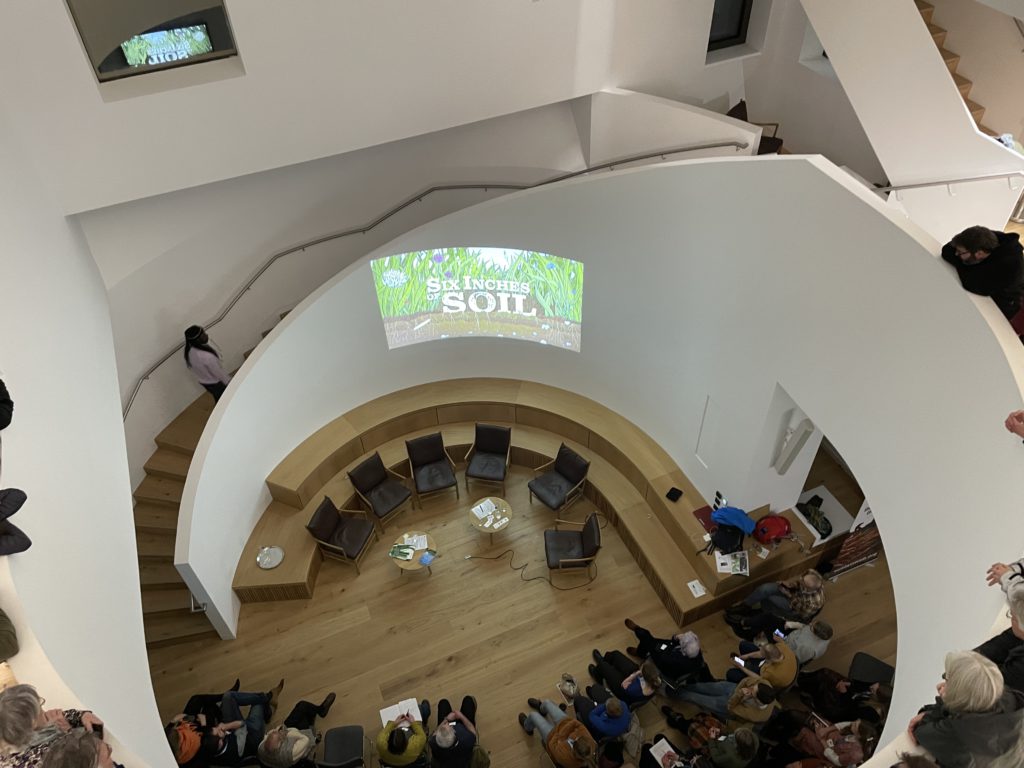
The post Farm Net Zero at Oxford Real Farming Conference 2024 appeared first on Farm Carbon Toolkit.
]]>The post Farm Walk with Carbon Farmer of the Year Finalist, Thomas Gent, Oakley Farm – 23rd May 2024 appeared first on Farm Carbon Toolkit.
]]>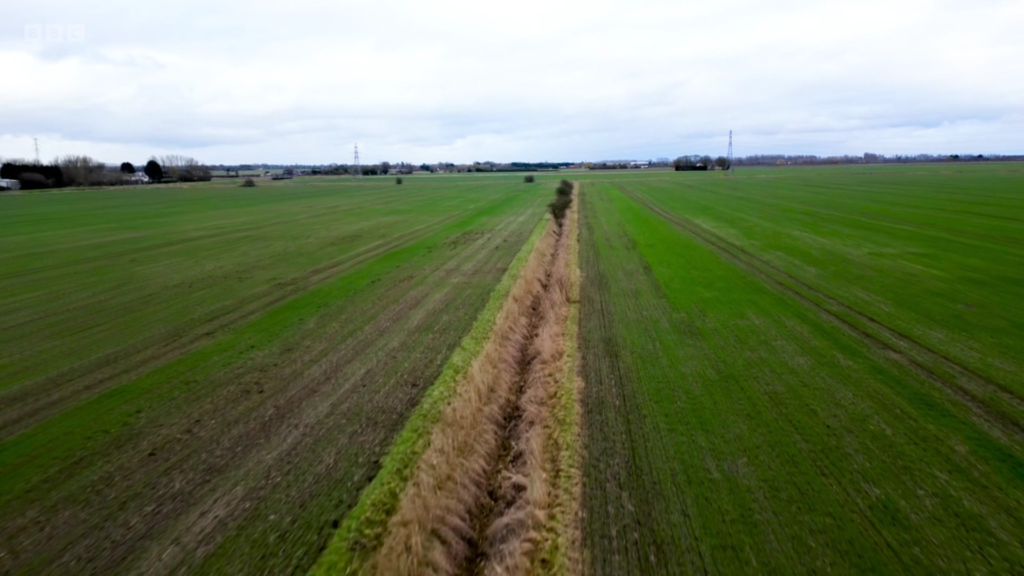
We are delighted to be able to invite you to attend this Farm Walk to hear from the team at Oakley Farm about how they run their arable farm following regenerative agriculture principles.
Farming with greenhouse gas emissions in mind, as well as all the other targets farmers work to, is fast becoming the norm.
Oakley Farm in South Lincolnshire has been in the Gent family for four generations. Now with father and son team Edward and Thomas managing the 800 ha business, they run their arable farm following regenerative agriculture principles.
Having already fully adopted minimal cultivations and the incorporation of cover crops across the farm, the team are now turning their attention to the potential to incorporate agroforestry and livestock onto their holding. Through continuously refining the management system Edward and Thomas have managed to produce 10 tonne/ha wheat crops with 150kg N and 30 litres diesel per hectare.
Event details
Location to meet/congregate : https://maps.app.goo.gl/UhwiPfPmZQYmCD8i6
What3Word: ///crank.frantic.rules
The farm walk will begin at 1.30pm and will provide an opportunity to find out more about Edward and Thomas’s strategy to reduce emissions on the farm and how this has benefited the business, leading Thomas to be named as one of FCT’s finalists in our first Carbon Farmer of the Year Competition.
The event will take place outside, please wear suitable clothing and footwear. Light refreshments will be provided.
How to book
This event is free but spaces are limited. Please book via our Eventbrite page by following this link
The post Farm Walk with Carbon Farmer of the Year Finalist, Thomas Gent, Oakley Farm – 23rd May 2024 appeared first on Farm Carbon Toolkit.
]]>The post Farm Walk with Carbon Farmer of the Year Finalist, Craig Livingstone, Lockerley Estate, Hampshire – 14th May 2024 appeared first on Farm Carbon Toolkit.
]]>
We are delighted to be able to invite you to attend this Farm Walk to hear from the team at Lockerley Estate about how they are working to reduce farm-based emissions whilst storing more carbon into soils and non-crop biomass.
Increasingly farming with greenhouse gas emissions in mind, as well as all the other targets farmers work to, is becoming the norm.
Lockerley Estate & Preston Farms, based near Stockbridge in Hampshire is a 2,000ha diverse estate which champions an approach to agriculture where biodiversity, soil health and the wellbeing of the community and future generations is at the heart of everything they do.
Craig Livingstone, Director of Farming & Estates, has four key aims to enable the estate to reduce emissions which are focussed on maximising soil carbon sequestration; reducing reliance on chemical inputs; using the wider estate to sequester more carbon and increasing the natural capital on the estate.
Event details
The farm walk will begin at 1.30pm and will provide an opportunity to find out more about Craig’s strategy to reduce emissions from the estate and how this has benefited the business, leading him to be named as one of FCT’s finalists in our first Carbon Farmer of the Year Competition.
The event will take place outside, please wear suitable clothing and footwear. Light refreshments will be provided.
How to book
This event is free but spaces are limited. Please book via our Eventbrite page by following this link.
The post Farm Walk with Carbon Farmer of the Year Finalist, Craig Livingstone, Lockerley Estate, Hampshire – 14th May 2024 appeared first on Farm Carbon Toolkit.
]]>The post Farm Carbon Toolkit teams up with LiveTrace appeared first on Farm Carbon Toolkit.
]]>
Farm Carbon Toolkit is delighted to announce the development of an integration between LiveTrace and the Farm Carbon Calculator softwares, underpinned by our longstanding collaboration with Mercian Ltd, the UK’s largest supplier of Crisping Potatoes.
Farm Carbon Toolkit is using its years of experience in Carbon footprinting to support carbon calculations on LiveTrace’s existing platform, bringing additional insights to the crisping potato supply chain and building on the joined-up approach LiveTrace provides for the industry.

Photo: Kai Oberhäuser, Unsplash
Farm Carbon Toolkit’s Calculator Development Manager Dr. Lizzy Parker explains the motivation behind the collaboration.
“For over a decade, the Farm Carbon Calculator has supported farmers to understand their business through a carbon lens. Farmers are all at different stages on their carbon journey, but we believe an important first step is to get farmers thinking about the options they have to reduce emissions and remove carbon from the atmosphere. By working with LiveTrace to bring insight to farmers who are already collecting the bulk of the data they need to calculate their carbon footprint, we can support a significant proportion of the industry to understand its role in reducing emissions“
We have worked closely with Mercian Ltd to improve our calculator for one of the most important agricultural sectors in the UK. We’re now excited to see how a more seamless user experience will support more farmers and their customers to engage with action to reduce emissions.”
“As the largest supplier of crisping potatoes in the UK we felt the time was right to take the initiative” explains Jon Kemp, Director of Livetrace. “The input we received from Farm Carbon Toolkit has been both professional and very much inspirational for us. This has led to a joint approach that is building our understanding of the carbon intensity within the crisping potato supply chain. We have leveraged the data which is already being collected by the LiveTrace software as part of the everyday farming activities, together with FCT’s expertise to understand the carbon impact and guide farmers to more sustainable practices.
We are truly hoping that technology such as this will help the UK potato industry play its part in the positive changes which are taking place across agriculture. “
About the Farm Carbon Toolkit
Farm Carbon Toolkit is an independent, farmer-led Community Interest Company, supporting farmers to measure, understand and act on their greenhouse gas emissions, while improving their business resilience for the future.
For over a decade, Farm Carbon Toolkit has delivered a range of practical projects, tools and services that have inspired real action on the ground. Organisations they work with include Velcourt, the Duchy of Cornwall, First Milk, Tesco and WWF. The Farm Carbon Calculator is a leading on-farm carbon audit tool, used by over 7,000 farmers in the UK and beyond. To find out more visit www.farmcarbontoolkit.org.uk
We created one of the first tools (Farm Carbon Calculator) to audit GHG emissions on farm in 2011 and were one of the first to include carbon removals as well as emissions within our audit.
For further information or to start your first carbon footprint visit calculator.farmcarbontoolkit.org.uk
The post Farm Carbon Toolkit teams up with LiveTrace appeared first on Farm Carbon Toolkit.
]]>The post Sustainable crop rotations appeared first on Farm Carbon Toolkit.
]]>Looking back at 2023, it can safely be defined as a challenging year with the wettest autumn / winter we have seen for decades. Farmers have not only faced the challenge of maximising yields and optimising soil health, but also battling against the elements to drill crops into the ground. Hoping for a kinder 2024, this blog explores options to build resilience into crop rotations aiming to cultivate a balance between high yields and optimum soil health.
Minimising cultivation
First things first, this blog is not telling you to get rid of the plough. All machinery serves a purpose, it is just about knowing when to intervene. Within systems that have reduced their cultivations or those that have been adopting conservation ploughing (i.e. ploughing one year in three or more), soils tend to be more resilient through improved soil structure. Good soil structure has a matrix of small, medium, and large pore spaces able to retain and drain water as well as provide pockets of air for respiration and gaseous exchange and water for nutrient exchange. When we till the soil, especially when ground conditions are sub-optimum, we run the risk of squashing the pores and causing compaction and soil degradation, reducing water infiltration, increasing anaerobism (lack of oxygen) and building up toxic gases, all contributing to poor soil health and disappointing crop yields.

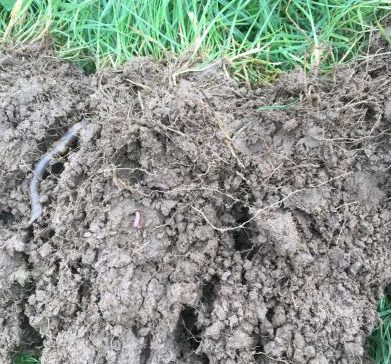
Carry out a VESS: Visual Evaluation of Soil Structure
It is important to get out there and dig holes; get to know your soil and how it behaves under certain environmental conditions. When you assess the soil structure, look for compaction and note its depth. Can this be remedied by deeper rooting species, or does it require mechanical intervention? Always keep the depth in mind as it’s no good going in too deep or too shallow.
Diversity
Sustainable rotations begin with diversity. A multipronged approach combining arable crops, legumes and cover crops takes full advantage of all the tools we have in the box as arable farmers. Diversity in species above ground matches diversity in species below ground: helping to break pest and disease cycles and improve soil health through provision of various rooting architecture, root exudates and crop residues. The soil is alive and many of the nutrients available to crops and plants come from the activity of soil-dwelling organisms that are busy stabilising, consuming and releasing nutrients for the benefit of the crop. Diversity in crops and roots therefore contribute a rich source of food for soil fauna to feast on, enhancing soil fertility and subsequent crop health and crop yield.
Where pests and disease more commonly thrive is within monocultures e.g. continuous cereals. We are seeing an increasing reliance on chemicals to control and abate problems within these systems, depleting our soils of beneficials in the process. Similarly, a lack of diversity in roots are only supporting a limited community of microorganisms. This is not sustainable; therefore, we must explore how we can incorporate more species within the rotation. OSR is one of many good examples. It has deep roots and is easily diversified with companions e.g. vetch / buckwheat / berseem clover. Maximising the number of crop species in a rotation will optimise the diversity of organisms below ground.
On farm, an easy way to measure how biologically active our soils are is by monitoring earthworm numbers. Earthworms are at the top of the soil food web and will travel to and reside where there is lots of food; they are also brilliant at breaking down residues and redistributing nutrients throughout the soil profile. How many worms do you count in a spade full of soil? Where are you finding the most? And can those numbers be replicated elsewhere on farm?
Legumes
The blog wouldn’t be complete without talking about legumes. Approximately 78% of the air is nitrogen. If we can harness the power of leguminous plants to fix some of that nitrogen, we can cut costs by reducing the amount of artificial fertiliser whilst also minimising our environmental impact. Consider incorporating peas or beans into the rotation as stand-alone crops, clover as a companion crop or include legumes as part of a cover crop mix. Farmers are often able to reduce the amount of bagged fertiliser used after legumes.

Legumes to build fertility: field beans in an arable rotation
If possible, trial a small reduction across a proportion of the field first and see how your yields fare – you might be pleasantly surprised.
Cover Crops
Utilising cover crops between winter and spring cropping is an excellent approach to building soil health in between cash crops: stabilising soil structure by maintaining living roots in the soil throughout the year, feeding the soil biology and acting as a buffer protecting the soil from adverse weather conditions.
On top of this, one of the biggest advantages of cover crops is that they are great at scavenging and holding onto residual nutrients left over from the previous crop, reducing losses from leaching. Once destroyed, the nutrients will be released back into the soil, improving nutrient use efficiency, and potentially enabling a reduction in artificial inputs required by the next crop.
Cover crop mixes should be tailored to your needs and soil type. It’s better to choose species type based on what you are trying to achieve: building fertility, keeping the ground covered, and/or alleviating compaction.
If possible, conduct trials and aim to include 3 or more species in the mix to capitalise on diversity in both the above-ground biomass for optimised photosynthetic potential (think assortment of leaf shapes to increase surface area from which to harness the sun’s energy), and below-ground biomass through varied rooting structures, depths, shapes and sizes (pumping sugars and carbon into the soil, building soil organic matter and feeding the soil biology).
Livestock Integration
Integrating grazing livestock into your rotation offers an alternative technique to destroying cover crops whilst also adding valuable organic matter to the soil in the form of manure. Including grass and clover leys also gives the ground a break, allowing time for recovery and offers another income stream from grazing or silage / hay making. The benefits of perennial roots in the ground over an extended period, especially if a mix of roots at different depths, will help to improve soil structure and build fertility for future crops.

Grazing livestock returning soil organic matter and building soil health.
Explore the Sustainable Farming Incentive options to see if herbal leys or a 2-year legume fallow could be economically viable.
Monitoring and Adapting
It is important to remember that there is no one-size-fits-all approach; be adaptive and tailor options to local environment and conditions. Trial different methods and see which suits your system best.
Regularly monitoring soil health, accounting for all nutrient sources, and keeping an eye on pest and disease prevalence alongside crop performance and weather is crucial to make informed adjustments to rotations as needed.
In summary, farmers are in a unique position in that yes, we produce emissions in the process of producing nutritious food however, we can also build soil health and boost biodiversity simultaneously contributing to offsetting our own emissions and future proofing our farms and landscapes. Implementing a sustainable crop rotation in the UK is not just about growing crops; it’s about promoting a future where productivity and soil health co-exist. By diversifying crops, integrating legumes, embracing cover crops, minimising tillage, incorporating livestock, and tailoring practices to local conditions, it is possible to achieve a resilient and sustainable agricultural landscape supporting local and wider communities for years to come.
The post Sustainable crop rotations appeared first on Farm Carbon Toolkit.
]]>